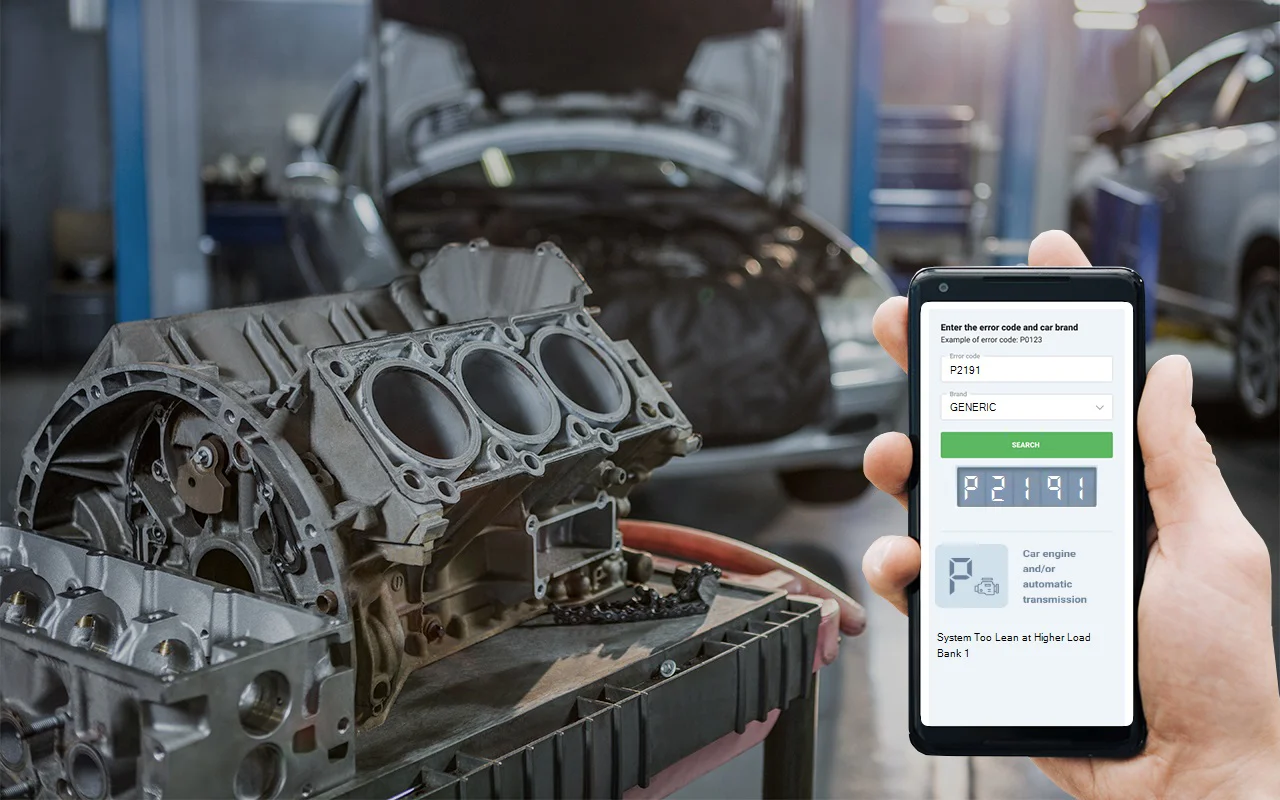Let me break down what the P2191 code means for you. This code pops up when your car’s computer (the PCM) notices that the engine is running too lean on Bank 1-that is, there’s too much air and not enough fuel in the mix. The PCM keeps an eye on things using sensors like the Mass Air Flow (MAF) sensor, Manifold Absolute Pressure (MAP) sensor, throttle position sensor, and especially the oxygen sensors in your exhaust. When these sensors report that the air-fuel ratio is off-specifically, too much air compared to fuel-the PCM flags it with this code. The goal here is to keep your engine running smoothly and efficiently, so when this balance is off, it can cause all sorts of drivability issues. Bank 1 just means the side of the engine with cylinder number one, and the exact location depends on your vehicle’s make and model.
DTC P2191
Causes of P2191 engine code
From what I see most often in the shop, there are a handful of usual suspects behind a p2191 code. Here’s what tends to go wrong:
- Faulty or clogged fuel injectors - If the injectors aren’t delivering enough fuel, you’ll get a lean mixture.
- Weak or failing fuel pump - Not enough fuel pressure means not enough fuel gets to the engine.
- Bad mass air flow (MAF) sensor - If this sensor is giving the wrong info, the PCM can’t balance the air-fuel mix right.
- Malfunctioning oxygen sensor - If the sensor is reading incorrectly, the PCM gets the wrong data and adjusts fuel delivery the wrong way.
- PCM software issues or rare PCM failure - Sometimes the computer itself needs an update or, in rare cases, replacement.
In my experience, it’s usually something simple like a dirty MAF sensor or a weak fuel pump, but you can’t rule out the others without checking.
Symptoms of dtc P2191
When this code is active, you’ll probably notice a few things. The most obvious is the check engine light coming on. You might also feel the engine lacking power, especially when you try to accelerate. Sometimes the engine will misfire or run rough, and you’ll likely see your fuel economy drop. If it gets bad enough, the car might hesitate or even stall. These symptoms can sneak up on you, so it’s best not to ignore them.

Diagnosis steps for P2191 code
Here’s how I usually tackle a obd p2191 step by step. First, I always start with a scan tool to check for any other codes-sometimes there’s more than one issue going on. Next, I’ll look at live data from the oxygen sensors and fuel trims to see if the engine really is running lean. After that, I check the basics: make sure the air filter isn’t clogged and that there are no obvious vacuum leaks (listen for hissing sounds or spray a little carb cleaner around the intake and see if the idle changes). Then, I move on to the MAF sensor-take it out and inspect it for dirt or oil, and clean it if needed. If that’s not the problem, I’ll check fuel pressure with a gauge to see if the pump is weak. After that, I test the injectors to make sure they’re working right. Finally, if all else fails, I’ll check the oxygen sensors and see if the PCM needs a software update. It’s best to start with the simple stuff before diving into the more complicated checks. If you’re not comfortable with these steps, it’s safer to have a pro handle it.

Common Mistakes with P2191
One thing I see a lot is folks jumping straight to replacing sensors without checking the basics first. For example, swapping out the oxygen sensor or MAF sensor before making sure there isn’t a vacuum leak or a clogged air filter. Another common mistake is overlooking fuel pressure-if the pump is weak, no amount of sensor replacement will fix the lean condition. Also, people sometimes forget to check for technical service bulletins (TSBs) that might point to a known issue or a software update. Skipping these steps can waste a lot of time and money.

Seriousness of obd code P2191
This isn’t something you want to put off. Running lean for too long can cause serious damage-think burnt valves, damaged pistons, or even a ruined catalytic converter. You don’t want this kind of trouble on the road, especially if the engine starts to misfire or lose power. Honestly, it’s dangerous to ignore this because things can go south quickly, and repairs get a lot more expensive if you wait.
How to Repair P2191 trouble code
Here’s what usually fixes a obd p2191, based on what I see in the field and in OEM procedures:
- Cleaning or replacing a dirty or faulty MAF sensor.
- Replacing clogged or malfunctioning fuel injectors.
- Repairing or replacing a weak fuel pump.
- Fixing any vacuum leaks in the intake system.
- Replacing a faulty oxygen sensor if it’s giving bad readings.
- Updating PCM software if there’s a known issue or TSB.
It’s important to address the root cause, not just clear the code, or it’ll come right back.
Conclusion
To sum it up, P2191 means your engine is running too lean on one side, and that’s a recipe for trouble if left unchecked. It’s best to tackle this as soon as possible-start with the basics like checking for vacuum leaks and cleaning the MAF sensor, then move on to fuel system checks if needed. The risk level is high because ignoring it can lead to major engine damage. The most reliable way to resolve it is to follow a step-by-step diagnosis, fix the underlying issue, and make sure everything is working as it should before getting back on the road.




